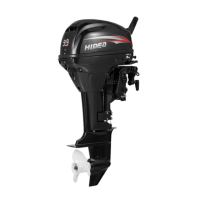
Do you have a question about the Hidea HDF9.9 and is the answer not in the manual?
| Engine Type | 4-Stroke |
|---|---|
| Cylinder | 2 |
| Max. Output | 9.9 HP |
| Full Throttle RPM Range | 5000-6000 RPM |
| Gear Ratio | 2.08:1 |
| Gear Shift Position | F-N-R |
| Cooling System | Water-Cooled |
| Starting System | Manual |
| Fuel Tank Capacity | 12 L |
| Shaft Length | 381 mm (15 in) |
| Control System | Tiller |
| Recommended Fuel | Gasoline |
Record outboard motor serial number for ordering parts and theft reference.
Explains safety warnings related to refueling, tilting, and operating near water.
Essential guidance on safe refueling procedures and gasoline handling.
Information on recommended gasoline and handling precautions.
Details on recommended engine oil type, grade, and quantity for 4-stroke motors.
Guidance on choosing the correct propeller for optimal performance and motor protection.
Identifies and illustrates key parts of the outboard motor.
Explains how to remove and use the fuel tank cap for filling.
Details on loosening the air vent screw for fuel flow.
Instructions on using the tiller handle for steering.
How to operate the throttle grip to control engine speed.
Adjusting resistance for the throttle grip for steady speed.
Explains the function and proper use of the engine stop lanyard switch for safety.
How to use the engine stop button to turn off the engine.
Operation of the choke knob for cold engine starting.
Procedure for starting the engine using the manual starter handle.
Adjusting steering resistance for operator preference.
Explains the function of the thrust rod in determining trim angle.
How to secure the outboard motor in the tilted-up position.
Procedure for removing and installing the engine top cowling.
Explains the engine oil warning lamp and its meaning.
Guidance on installing the outboard motor, considering engine height and water spray.
Instructions and considerations for correctly mounting the outboard motor on the boat transom.
Optimal mounting height for efficiency and to prevent cavitation or overheating.
How to securely clamp the outboard motor to the transom.
Procedure for breaking in a new engine to ensure longevity and performance.
Specific break-in steps for 4-stroke engines under load.
Essential checks to perform before operating the outboard motor for safety.
Checks for throttle, shift, and steering operation before starting.
Checks related to the engine and its mounting, including fasteners and propeller.
Procedure for checking the engine oil level using the dipstick.
Instructions for safely refueling the integrated fuel tank.
Steps and safety precautions for starting and operating the engine.
Detailed steps for starting the engine, including manual start models.
Specific instructions for starting the engine using the manual pull-start system.
Procedure for warming up the engine after starting for optimal performance.
Instructions and warnings for shifting between gears (forward, neutral, reverse).
How to engage forward and reverse gears safely and effectively.
Procedure for properly stopping the outboard motor.
Adjusting the motor's angle for optimal boat trim, performance, and fuel economy.
How to change the outboard motor's trim angle using the adjustment holes.
How trim affects boat performance (bow-up/down) and stability.
Procedures for tilting the outboard motor up or down for protection and maintenance.
Step-by-step guide for tilting the outboard motor into the raised position.
Step-by-step guide for lowering the outboard motor from the tilted position.
Technical specifications for the outboard motor, including dimensions and performance data.
Recommended fuel types, capacities, and engine oil specifications.
Specifications for tightening torque values for engine components like spark plugs and nuts.
Guidelines for safely transporting and storing the outboard motor.
Procedures for proper long-term storage to prevent damage.
Instructions on how to clean, inspect, and adjust spark plugs for optimal engine function.
Procedures for inspecting the fuel system for leaks and proper function.
How to check and verify the engine's idling speed.
Step-by-step guide for changing the engine oil, including frequency and safety.
How to inspect wiring and connectors for secure connections and proper grounding.
Checking for exhaust leaks from engine components.
Checking for water leaks from engine components.
Checking for oil leaks around the engine.
Inspecting the propeller for wear, damage, or entanglement.
Step-by-step instructions for removing the propeller.
Step-by-step instructions for installing the propeller securely.
Procedure for changing the gear oil, including draining and refilling.
How to inspect and replace sacrificial anodes for corrosion protection.
Advice on hull cleaning and anti-fouling paint for performance.
Common problems and their potential remedies for poor starting or loss of power.
Troubleshooting steps when the starter motor fails to engage.
Steps to diagnose why the engine won't start even if the starter works.
Explains the meaning of indicator lights like low engine oil.
Diagnosing reasons for reduced engine power and potential solutions.
Procedures for handling impact damage and emergencies.
Steps to take if the outboard motor sustains impact damage.
How to start the engine using an emergency starter rope.
Procedures to minimize damage if the outboard motor is submerged in water.